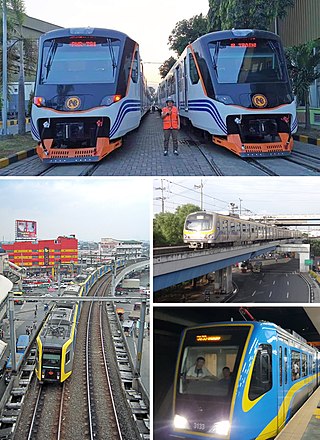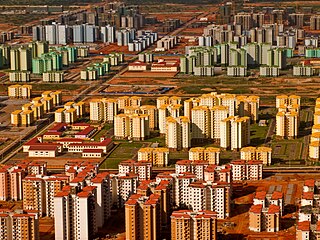Related Research Articles

Luanda is the capital and largest city of Angola. It is Angola's primary port, and its major industrial, cultural and urban centre. Located on Angola's northern Atlantic coast, Luanda is Angola's administrative centre, its chief seaport, and also the capital of the Luanda Province. Luanda and its metropolitan area is the most populous Portuguese-speaking capital city in the world and the most populous Lusophone city outside Brazil, with over 8.3 million inhabitants in 2020.

The Mumbai Metro is a rapid transit (MRT) system serving the city of Mumbai and the wider Mumbai Metropolitan Region in Maharashtra, India.

Metrorrey, officially Sistema de Transporte Colectivo Metrorrey, is a rapid transit system in Monterrey, Nuevo León, Mexico. Operations began in 1991. As of 2021, the system operates 50 high-floor electric trains, along a total system of 40 stations with a length of 40 kilometers (25 mi).

Rail transportation in the Philippines is currently used mostly to transport passengers within Metro Manila and provinces of Laguna and Quezon, as well as a commuter service in the Bicol Region. Freight transport services once operated in the country, but these services were halted. However, there are plans to restore old freight services and build new lines. From a peak of 1,100 kilometers (680 mi), the country currently has a railway footprint of 533.14 kilometers (331.28 mi), of which only 129.85 kilometers (80.69 mi) are operational as of 2024, including all the urban rail lines. World War II, natural calamities, underspending, and neglect have all contributed to the decline of the Philippine railway network. In the 2019 Global Competitiveness Report, the Philippines has the lowest efficiency score among other Asian countries in terms of efficiency of train services, receiving a score of 2.4, and ranking 86th out of 101 countries globally. The government is currently expanding the railway network up to 1,900 kilometers (1,200 mi) by 2022 through numerous projects.

The Lille Metro is a driverless light metro system located in Lille, France. It was opened on 25 April 1983 and was the first to use the VAL system. While often referred to as the first fully automated driverless metro of any kind in the world, the Port Liner in Kobe, Japan predates it by two years. The light metro system is made up of two lines that serve 60 stations, and runs over 45 kilometres (28 mi) of route.
This is a list of planned, or proposed, high-speed rail projects by country. Although a number of countries have conducted preliminary feasibility studies, many lines are eventually shelved or postponed due to high costs; only a few nations are building high-speed rail lines. Planned lines are separated here from lines under construction, and some countries have both. High-speed rail is public transport by rail at speeds over 200 km/h.

The Moçâmedes Railway is an 860 km railway line in Angola, between Moçâmedes and Menongue. The line is operated by the company Caminhos de Ferro de Moçâmedes E.P. The port city of Moçâmedes was renamed Namibe between 1985 and 2016, so the railway was sometimes called the Namibe Railway. However, the railway company retained its original legal name.

Abuja Rail Mass Transit commonly known as Abuja Light Rail is an abandoned regional rail transport system in the Federal Capital Territory of Nigeria. It was the first rapid transit system in the country, West Africa, and the second such system in sub-saharan Africa. The first phase of the project connects the city center to Nnamdi Azikiwe International Airport, stopping at the Abuja-Kaduna Railway station in Idu. The Abuja Metro Line was launched on 12 July 2018 and a three-trains-per-day service opened for passengers the following week. Passenger services on the line were suspended in early 2020 due to the COVID-19 pandemic, and had still not resumed as of September 2023.

The Dhaka Metro Rail, or simply the Dhaka Metro, is a mass rapid transit system serving Dhaka, the capital and largest city of Bangladesh. It is owned and operated by the Dhaka Mass Transit Company Limited (DMTCL). Together with the under construction Dhaka BRT, proposed Dhaka Subway and Dhaka suburban circular rail, it is expected to reduce traffic congestion in the city. The metro rail network has five planned lines which are the MRT Line 6, the only operational line, MRT Line 1 and 5, which are under construction, and MRT Line 2 and MRT Line 4, which are in the planning stages. It is part of the Strategic Transport Plan outlined by the Dhaka Transport Coordination Authority (DTCA).

The history of rail transport in Angola began during the nineteenth century, when Angola was a colony of Portugal. It has involved the construction, operation and destruction of four separate, unconnected, coast-to-inland systems, in two different gauges. Operations on three of those systems have been largely restored; the other system has been closed.

Nagpur Metro is a rapid transit system for the city of Nagpur, Maharashtra, India. Phase I of the metro project cost was estimated to cost ₹8,650 crore but the final project cost incurred was ₹9,279 crore (US$1.2 billion). In February 2014, the Government of Maharashtra gave approval for the Metro project, while the Government of India's Ministry of Urban Development had given "In Principle" approval for the project. On 20 August 2014, Union Cabinet gave approval for the development of the project, and the Prime Minister laid the foundation stone on 21 August. Construction began on 31 May 2015, with trial run beginning on 30 September 2017.

Quilamba is an Angolan neighborhood that serves as the administrative center of Belas Municipality and a large housing development site 30 km from Luanda, the capital city of Angola. It is being built by the China International Trust and Investment Corporation.

Rapid Metro Gurgaon is a light metro system serving the city of Gurgaon, Haryana, India. Rapid Metro connects the commercial areas of Gurgaon, and acts as a feeder link to the Delhi Metro with an interchange with its Yellow Line at Sikanderpur metro station.

The Sydney Metro is a fully automated rapid transit system in Sydney, New South Wales, Australia. The first component, the Metro North West Line, opened on 26 May 2019, running from Tallawong to Chatswood. It currently consists of 13 stations and 36 km (22.4 mi) of twin tracks, mostly underground. Work is progressing to extend this line from Chatswood to Bankstown as part of the City & Southwest project, which will run under Sydney Harbour and the Sydney Central Business District (CBD), with a scheduled 2024 completion. When completed, the entire line from Tallawong to Bankstown will have 66 km (41.0 mi) of twin tracks and 31 stations.

The O-Train is a light rail rapid transit system in Ottawa, Ontario, Canada, operated by OC Transpo. The O-Train system has two lines, the electrically-operated Confederation Line and the diesel-operated Trillium Line. Since May 2020, Stage 2 construction has temporarily shut down Line 2, with replacement bus service being offered at all stations. When Line 2 reopens in 2024, it will extend southward to Limebank station and incorporate five newly constructed stations, as well as an additional line linking Line 2 to Ottawa International Airport which will replace the current bus service from route 97. By 2026, expansions along Line 1 and the construction of Line 3 stations in the west end are expected to be complete, bringing the system's length to 64.5 km (40.1 mi), four lines and 41 stations. The O-Train network is fully grade separated and does not have any level crossings with roads. As such, it falls within the category of a light metro.

The Laúca Hydroelectric Power Station is a 2,070 MW (2,775,916 hp) hydroelectric power plant in Angola. It is the largest power station in the country.
Sydney Metro West is a rapid transit underground rail project currently under construction in Sydney, New South Wales, Australia. It involves constructing a rail line from Hunter St in the northern Sydney City Centre (CBD) to Westmead in the western suburbs of Greater Sydney which will generally run parallel to the existing Main Suburban and Main Western railway lines, but via different suburbs and different stations, with the main aims being the doubling of rail capacity between the City Centre and Greater Western Sydney and the relief of overcrowding on the Western Line. The line will form part of the Sydney Metro network.
The Phuket Island Light Rail Transit project is a planned 58.6-kilometre (36.4 mi) MRTA light rail transit system for Phuket and Phang Nga provinces in Thailand. The line will consist of 24 stations running from Takua Thung District in Phang Nga Province to Phuket City and terminating at Chalong intersection. The line will have at-grade and elevated sections. The cost of the project is estimated at 35 billion baht.
The city of Bristol in the United Kingdom has included a light rail transport system in its plans from the 1980s onwards. There has been no light rail in the city since the closure of Bristol Tramways in 1941.

Urban rail transit in Africa has emerged as a growing form of transit due to rapid urbanization that has occurred in recent decades across the continent. Some of these transit systems are older and more developed, such as the metro in Cairo which opened in 1987. Others such as the light-rail system in Addis Ababa are much more recent, which opened in 2015. A variety of technologies are being used ranging from light-rail, bus rapid-transit, and commuter-rail etc. Africa for several decades saw minimal investment in rail infrastructure, but in recent years due to urban population growth and improved financing options, investment in rail networks has increased.
References
- ↑ "Luanda surface light rail system will cost US$3 billion – Macauhub". Macauhub. 6 November 2019. Retrieved 6 November 2019.
- ↑ "German transportation company to build Luanda Surface Metro". Xinhua . 8 February 2020. Retrieved 15 March 2020.[ dead link ]
- ↑ "Metro de superfície de Luanda arranca com 149 km". Diário Imobilário (in Portuguese). 8 November 2019. Retrieved 15 March 2020.
- ↑ "Metro de superfície une Porto de Luanda à centralidade do Kilamba". vanguarda.co.ao. 1 December 2020. Retrieved 29 December 2020.